Airbag packs have become a commodity. Not because they are everywhere, but because so many different pack makers are offering one. Which means that, once you decide you need one of these, there is bound to be one that one will strike your fancy simply as a pack, regardless of the type of airbag it may use. To be sure, airbags systems force compromises in the design of packs, but insurance never comes without a cost.
Ignoring the features of the pack for a moment, there are two basic airbag systems available in Fall 2013, with a revolutionary third to come by Fall 2014. Both work by releasing a cartridge of compressed gas to fill the airbag. However, the compressed gas in the canister is not enough to fill the airbags on their own. In fact, more than half the air in the bag is drawn in from the surrounding space via a venturi valve. The speed of the gas expanding out of the canister draws in enough additional air through the venturi valve to fill the air bag.
Inverse What?
The reason airbag packs can save lives in an avalanche is NOT because the airbag lifts you up, like a hot air balloon rises in air. Rather it works on a principle known as inverse segregation, which is a scientific term to describe why the crumbs always fall to the bottom in a bag of chips while the big ones stay on top. In a turbulent flow of particles, the large ones tend to stay on top, the small ones sift to the bottom. Thus, the airbag helps to keep a skier on or near the surface because it makes the wearer bigger by increasing their overall volume.
The originator of the concept, ABS uses dual-airbags filled using compressed Nitrogen. Other systems use simple compressed air, with a single airbag. This latter system comes in three flavors, defined by the type of release valve used, and the shape and/or position of the airbag when inflated.
| Manufacturer | Model | Airbag | Filler | $/use | IATA | TSA |
| ABS | Vario | 2x 85 l cylinders | N2+AA | $50-$100 | Y | Empty-Y, Full-N |
| BCA | Float | 150 l 2D shaped | CA+AA | $20-$60 | Y | Empty-Y, Full-N |
| Mammut/Snowpulse | P.A.S. | 150 l 3D shaped | CA+AA | $20-$60 | Y | Empty-Y, Full-N |
| Mammut | R.A.S. | 150 l 2D shaped | CA+AA | $20-$60 | Y | Empty-Y, Full-N |
| Wary | Wary | 150 l 2D shaped | CA+AA | $20-$60 | Y | Empty-Y, Full-N |
| Black Diamond | Jetforce | 200 l shaped | ElxFan+AA | ? ? ? | ? | Unknown |
CA=Compressed Air • N2=Compressed Nitrogen • AA=Ambient Air
Cost per inflation values are estimates only, due to unknown shipping costs
The ABS Way – Compressed Nitrogen
ABS started out using compressed air for their airbag packs, and a single airbag. With experience they determined that two bags are better than one. In the best case of a bad situation, two airbags provides more volume around the torso of the user, helping keep the head above the snow. In a worst case scenario, two airbags provide a sort of fail-safe redundancy in the event that one either doesn’t inflate, or is punctured in the turmoil.
Though rare, ABS determined that a few of their early failures occurred because the venturi valve iced up from the temperature dropping as the compressed CO2 expanded, freezing the moisture of the incoming air. That was the motivation to switch to an inert gas like Nitrogen, where the possibility of icing up is practically eliminated.
The ABS system uses a pyro-technic trigger, which is to say, the seal on the canister is pierced with a small, highly focused pyro-technic charge. The explosive nature gets the the modern police state in a tizzy so they have the option to interpret your life saving airbag pack as a second amendment issue. This means traveling through an Amerikan airport with one is an exercise in bureaucratic paperwork and lemming compliance with ridiculous regulatory procedures. The IATA does stipulate an exception for traveling with these on an airplane, but the simpler solution is to fly without the cartridge and either rent/borrow one at your destination, or ship one ahead of time.
Two other features make the ABS compelling. The core technology is licensed by more pack manufacturers than any other system. In addition, they make a Vario system that contains the core elements of the airbag system in a frame. Multiple pack designs, from many different manufacturers are available to chose from.
And finally, ABS is the only system that has a remote, wireless activation system. Sometimes the victim is unable to activate the airbag themselves. The remote trigger allows someone else within their group (selectable between anyone, or only the guide) to activate the system.
ABS has the longest track record of lives saved, and the highest price.
The Compressed Air Way
Using an inert gas like Nitrogen may prevent the venturi valve from icing up, but competitors claim that simple compressed air works equally well at a lower cost. According to Bruce Edgerly, VP of Marketing with BCA, “We’ve never seen an ejector ice up using compressed air. When BCA and the dive shops fill cylinders we always dehumidify the air before it goes in the bottle. This is standard practice. Even if some water vapor were somehow present and it froze, it would have no problem going through the system, since the pressure is so high.”
Perhaps the strongest reason for using a compressed air system is the ability to discharge and refill the cartridges easily and less expensively than replacing ’em with sealed cartridges of compressed nitrogen. If you’re filling at a local retailer you’ll pay half to the same price as for a new cartridge. Check around though, you might be able to swing a free refill at your local fire station.
Being able to empty the cartridge makes traveling potentially easier, although you still need to be on your most subservient behavior with all the proper paperwork in order because some ignorant member of the tyranny squad thinks your airbag pack can explode. Refilling a cartridge when traveling is a pain in the butt, but that’s part of the price you pay for being “safe.”
The distinguishing differences among the compressed air gang – Mammut/Snowpulse, BCA, and Wary, are largely with the trigger, or release valve. In the case of the original Snow Pulse configuration, what Mammut calls their Protective Airbag System, the shape of the airbag is patently different.
Compressed air systems typically cost a bit less, and have a much shorter track record of saves. Although they all use compressed air, the cartridges are not interchangeable between systems. In other words, a cartridge in a BCA system will not work with a Mammut/SnowPulse or Wary system, and vice versa.
Mammut/Snowpulse
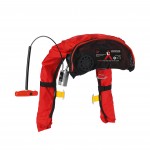
The original SnowPulse system created an airbag that surrounded the wearers head, extending down the front of the victim’s torso.
The Mammut/Snowpulse system comes in two flavors. The original system developed by SnowPulse that used an airbag that not only expanded behind the wearer’s head, but around and down the either side, expanding out from the shoulder straps of the pack. Mammut now markets this system is their patented Protective Airbag System, denoted PAS.
The other option is their Removeable Airbag System, which sports an airbag that expands behind the users head and along the sides down to about the bottom of the scapula bone. This is very similar to the remaining types of airbags described below.
Both PAS and RAS use a pierce valve that punctures the sealing disk on the canister, releasing the air inside. Once pierced, the disk and an O-ring need to be replaced. You will need to buy some spare disks and rings if you intend to practice at least once a season.
Once you have released the air, not only does the cap on the cannister need to be replaced, but there is a safety pin in the trigger mechanism that needs to be cocked into position with a special key that you need to keep with the pack at all times. Probably wouldn’t hurt to buy a spare key.
At the moment, this is the second most prevalent airbag system available on the market, due to the number of licensed users of Mammut’s protective and removeable airbag systems.
Backcountry Access
BCA’s airbag system uses compressed air with a mechanical valve that needs to be reset after pulling the trigger. It is, characteristically simple, like their avalanche beacons are to operate. You don’t need to replace the seal, but you do need to reset the trigger after each discharge. Also, the valve is permanently attached to the cartridge. Unlike Mammut/SnowPulse or ABS, this mandates a two cable system; one for the trigger to release the valve, a second to provide a tube for the air to escape through to fill the airbag.
The airbag is simple as well, expanding behind the users head and down the side of the pack to about the scapula. The standard size is 170 liters.
Wary
Wary’s system is similar to the BCA system in that it uses a mechanical valve to release the compressed air from the cartridge. It is just a slightly different mechanical design. The head of the compressed air cylinder has a casing that houses the trigger and firing pin. When deployed, the trigger pulls upward, allowing the firing pin to slide horizontally, releasing air.
Refilling cylinders requires the replacement of the O-ring located at the end of the firing pin. This is required because as the air passes by the O-ring upon deployment, the temperature of compressed air drops significantly, damaging the O-ring. Simply unscrew the casing to access the firing pin, pull off the old one, put on a new one, and you’re good to go.
As with the BCA system, two cables are connected to the head of the cartridge; one for the trigger, the other for the air to escape through.
The Wary system offers two balloon shapes; a simple square pillow that expands behind your head, and a shaped airbag that extends down the side of a pack to about the scapula bone in your back.
Black Diamond’s Jetforce System
Black Diamond has patents on an imminent system they are calling Jetforce. It will be officially introduced in October 2013 at the International Snow Science Workshop in Grenoble, France.
According to one BD insider, the airbag is filled using, essentially, a leaf-blower fan. Electric power comes via rechargeable batteries. It will reliably fill the air bag four times before needing a recharge.
This design is poised to revolutionize the airbag pack market and give even more weight to Black Diamond’s clout in the outdoor market.
Early figures on weight suggest this system won’t be much lighter than existing airbag systems, although one can hope that in time the weight of the fan components could be reduced while batteries increase in capacity.
The main advantages of this system are three-fold. The most important is the ability to get multiple inflations from a single charge. This means you can practice filling the airbag every time you head out for a day trip at least once, maybe even twice, without incurring any cost save the time to repack the airbag.
Anyone who has ever practiced using an avalanche beacon knows – it may not be difficult, but that device is a whole lot more valuable if you are familiar with its operation through regular practice. That would be even more true if you needed to rely on an airbag trigger that you only practice once a year with (if that) because it costs a lot of time plus $50 in a refill every time you do. Practice implies cost and inconvenience.
That’s the other part of the equation. The maintenance costs of the airbag system. With an electric fan, it might cost you $1.00 to recharge your batteries, if that, plus the obligatory repacking of the airbag. At that price, you could potentially have 200 practice sessions for $50 versus one.
In addition, it is hard to foresee the TSA getting testy because of a leaf-blower in your pack, although they might have a case when it comes to lithium ion batteries known ability to ignite. How ironic that this pack might save you from asphyxiation in an avalanche, yet kill you with third degree burns.
Lest you worry about Black Diamond monopolizing the market, Arc’teryx has been working on a similar system but mums the word from Canada’s great white north. Arc’teryx chief brainiac, Michael Blenkarn agrees, it means “practice makes perfect” can be affordable with airbag packs.
Guidelines for Flying with Airbag Packs
Related Posts
Review of ABS Vario 25
Review of BCA Float 36
Review of SnowPulse Highmark 22
Review of The North Face Patrol 24 ABS Pack
Review of Mystery Ranch Blackjack
Review of Oakley SnowMad RAS Pack
© 2013
Pages:
- 1
- 2

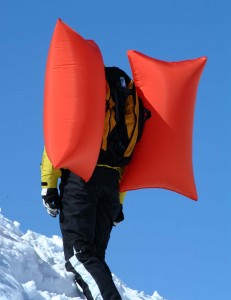
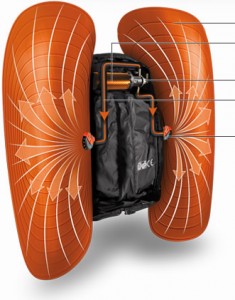
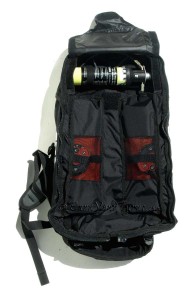
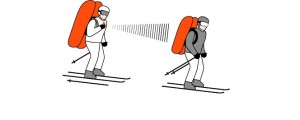
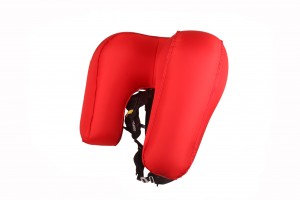
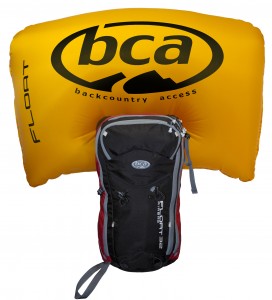
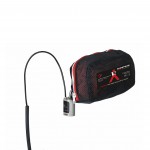
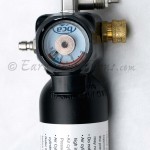
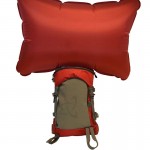
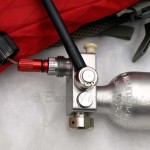
2 comments
2 pings
I flew to argentina from san francisco in august this year. TSA at SFO were concerned about the pack with empty air tank in my checked luggage. I was using a BCA Float 32. TSA called me to a desk and had me unscrew the top off the empty air tank so they could look inside. They clearly were not concerned about the tank exploding enroute due to pressure, but they were concerned it could have been packed with explosives. I was told when I fly with it to leave the regulator only very lightly screwed on so it would be easy to remove and the inside of the tank could be inspected for explosives. I did so, and when returning from South America I made sure the regulator was barely on, but when I got home and checked the unit, the regulator was very tightly screwed on the tank. So TSA inspectors had clearly removed the regulator and then replaced it. So my experience makes me believe the gossip about TSA thinking the pressurized tanks may explode is not the problem, they are concerned about explosives being packed into the tanks if word gets out the inside of the tanks are not visually inspected.
Good report, Craig! Thanks for writing an excellent survey of airbags
[…] Related Posts Overview of Airbag Pack Systems […]
[…] quick conclusion that you want the best system you can get, and the reality is, as of Winter 2014, the ABS system remains the premier system for a number of reasons. It has two airbags for a total volume of 170 […]